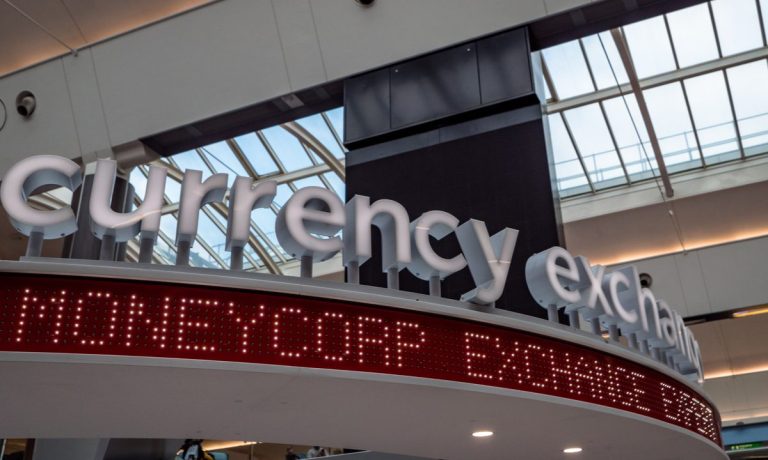
Predictable foreign exchange (FX) markets are what cross-border and import-export businesses seek in general. It’s easy to make plans on the assumption that exchange rates won’t change drastically.
So with the pound plunging to an all-time low against the dollar on Sept. 26, the world of U.K. businesses that rely on the FX market was turned upside down, making it a busy week for foreign exchange specialists like Moneycorp.
Read more: Pound, Euro Instability Signals Stress Ahead for Europe’s FinTech Ecosystem
In an interview with PYMNTS, Bryan McSharry, Moneycorp’s Europe CEO, said that many of their small medium-sized business (SMB) clients have reached out for assistance, and this has meant trying to understand the nature of both their current and future exposures, as well as discussing “hedging strategies that are available to them to mitigate the foreign exchange risks.”
Eoin Walsh, head of trading at Moneycorp Ireland, added that when there is a sudden uptick of volatility such as has been seen recently, a level of panic sets in, “not just for those who are impacted negatively, but also for those who are impacted positively.”
In the Irish context, where around a third of all exports go to the U.K., export businesses are especially feeling the effects of the recent plummet in the pound. In Ireland’s agricultural sector especially, Walsh said that “a rapidly deteriorating sterling is a significant headwind” for export businesses.
As a result, export businesses have been turning to Moneycorp for guidance on how the market will likely evolve over the coming weeks and months and to learn of any strategies that they can employ to “mitigate against a further sterling downside,” he noted.
Read on: SMBs Turn to Cross-Border Payments Tech to Tame FX Uncertainty
For other businesses, the challenges presented by the sliding pound are different.
As McSharry noted, “There’s also a community of exporters who in theory have become more competitive internationally because, if I’m bringing in a JCB [construction equipment] from the U.K. into Ireland, [for example], the price of that JCB has become cheaper for me in euro terms because sterling is cheaper.”
But even these businesses have been seeking advice on how best to navigate the turbulent currency market.
“Importers into Ireland may be tempted to take advantage of a rapidly depreciating sterling by purchasing more for future dates than they might have had the move not happened,” Walsh explained. But equally, they need to be able to predict with great certainty the flows that will be required, and in periods of high volatility, demand becomes harder to predict.
That said, the Irish economy is far more diverse than importing and exporting to the U.K.
Pointing to the country’s thriving software sector and a significant MedTech sector in the west of Ireland, Walsh observed that there are certainly export-focused businesses that have benefitted from a stronger dollar in recent times. He warned, however, that “dollar strength isn’t necessarily a one-way street” and that other factors besides a currency tailwind also impact demand.
Learn more: Mastercard Opens European Tech Hub in Dublin
Hedging Against Unpredictable Currency Market
If the events of the past year demonstrate anything, it’s that many of the old rules no longer apply. For example, whereas the traditional expectation has been that increasing interest rates are associated with a strengthening currency, in 2022, that truism hasn’t held.
The “typical relationship between interest rates and currencies has broken down to some degree,” Walsh argued.
In fact, while rate hikes by the U.S. Federal Reserve this year have broadly supported the strength of the dollar, with the dollar index up nearly 20% in the last year, the same cannot be said for Europe.
As Walsh observed, back in May, in anticipation of the European Central Bank raising interest rates, the euro softened on the expectation that a rate hike would inhibit the EU’s ability to accelerate its slowing economic growth.
Then this month, when the Bank of England’s (BoE) September rate hike coincided with the U.K. government’s tax-cutting budget announcement, the result was a substantial deterioration in the strength of the pound.
Related: Potential BoE Shakeup in the Cards as New UK Chancellor Seeks to Control Inflation
For cross-border businesses, such events create a “difficult dynamic for people to analyze because of the breakdown in the relationship between raising rates and the currency,” Walsh noted, adding that it creates “significant difficulties” for companies trying to forecast the different interest rates that affect doing business in multiple currencies.
The U.K. has moved to provide some relief, with the BoE recently deciding to delay planned bond sales and instead begin purchasing long-dated gilts “to restore orderly market conditions.”
The central bank warned that if dysfunction in the market continues or worsens, there will be “a material risk to UK financial stability. This would lead to an unwarranted tightening of financing conditions and a reduction of the flow of credit to the real economy.”
For all PYMNTS EMEA coverage, subscribe to the daily EMEA Newsletter.